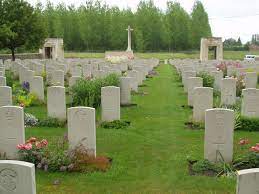Sydney Watmough
Date of birth: 1894
Date of death: 30.6.1916
Area: Brotherton
Regiment: Machine Gun Corps (Infantry)
Family information: Son of William and Sarah Hannah Watmough
Rank: Private
Service number: 28015
War Service
Sydney Watmough was enlisted into the King’s own Yorkshire Light Infantry, then in the Machine Gun Corps (MGC).
A year of warfare on the Western Front proved that, to be fully effective, machine guns must be used in larger units and crewed by specially trained men. To achieve this, the Machine Gun Corps was formed in October 1915 with Infantry, Cavalry and Motor branches, followed in 1916 by the Heavy Branch. A depot and training centre was established at Belton Park in Grantham, Lincolnshire, and a base depôt at Camiers in France.
The Infantry Branch was by far the largest and was formed initially by the transfer of battalion machine gun sections to the MGC, these being grouped into Brigade Machine Gun Companies, three per division. Three MGCs were formed on the 26 January 1916 at Grantham and moved into the 1st Division of the army. As Sydney was not in a ‘theatre of war’ throughout 1915 it is likely that he was in a reserve division of the K.O.Y.L.I. And then transferred to one of newly formed MGC’s. in the 1st Division.
Plans for the Battle of the Somme dated back to late 1915, and as the Anglo-French offensive approached in the early summer of 1916 it had become much more of a British affair, given the drastic situation at Verdun. Disguising the huge build-up on the Somme had proved problematic, and in an attempt to confuse the Germans as to the true location of the attack, a number of diversionary operations were planned. The best known is the assault at Gommecourt, but it is largely forgotten that others took place as well. The 1st Division attacked the Double Crassier at Loos on 30th June. The word ‘crassier’ literally means 'dump' and these were ‘slagheaps’ formed from mining waste. These two slag heaps are a major terrain feature and were the scene of heavy fighting during the Battle of Loos (1915). They stand nearby where the main Pit Head stood within the town of Loos.
Sydney Watmough was killed on 30th June 1916 and almost certainly in the attack at Loos.
He is buried in the St Vaast Post Military Cemetery which lies near the village of Richebourg-l'Avoue in the Pas-de-Calais, six miles North-East of Bethune on the main road to Armentieres and a few miles to the West of Loos. L'Avoue remained in British hands from the Autumn of 1914 to 9th April 1918, though the front line was within a mile of it. The strong point from which the cemetery was named was in turn named from the hamlet of St. Vaast, between the village of Richebourg-St. Vaast and Goix-Barbee. It stands in an old orchard between two farm buildings, where a trench tramway had its terminus and a Dressing Station was established. It was begun in May 1915, at the time of the Battle of Festubert, and used by fighting units and Field Ambulances until July 1917. It was recovered in September 1918.
Family Life
Born on 22nd October 1894 Sydney was the son of William (born about 1858) and Sarah Hannah (nee Veitch).
They lived in Watmough Yard off the High Street, Brotherton. Sydney’s grandfather was John George William Watmough who was born about 1821 in Inverary, Scotland. He moved to Brotherton sometime before 1951 as in the census of that year he was living with his cousin - Caroline Longstaff and her 5 year old son John.
She was a widow and John George was described as a ‘retired farmer’ at the age of 29 (?). Caroline nee Atkinson married John Watmough on 13th September 1853 but had previously been married in 1844 to John Longstaff, a butler to Sir John Ramsden who died in 1847.
In 1861 John was in employment as an “Overseer” and his stepson John Longstaff a ‘Commission Agent’. His two sons to Caroline were George Isaac born 1855 and William in 1859.
By 1871 Caroline was said to be an ‘annuitant’, which presumably meant she was in receipt of a pension of sorts. John had died in 1866.
Ten years later the family lived on the North Road and George was an ’Apprentice Joiner with William Dixon whilst William Watmough was a ‘Grocer and Draper Assistant’. Later that year William married Sarah Hannah Veitch who was from Castleford. In the next few years they had three children – Percy Alexander (1882), William Henry (1888) and Maskill (1889). George Watmough died in 1891.
After 1891 four more children came along – Sydney (1894), Frances Jane (1896), George Heathcote (1897) and Lily (1900). By this time William was a ‘Shopkeeper’ in the High Street.
By 1911 William still listed as a ‘Grocer Dealer’ and four of his sons were employed. William Henry as a ‘’Boot Repairer’, Maskill as a ’Bricklayer’s Labourer’, Sydney as a ‘Farm Labourer’ and George as a ‘Newsboy’.
Sydney was unmarried and had no issue but did have a nephew - Arnold Watmough born about 1915 and a niece called Norah Watmough (1915). His sister, Lily Watmough continued to operate as a grocer well into the second half of the 1900’s and I well remember entering the tiny shop at the head of Watmough’s Yard as a child when visiting my grandmother in Austerberry Yard.
 St Vaast Post Military Cemetery
St Vaast Post Military Cemetery

